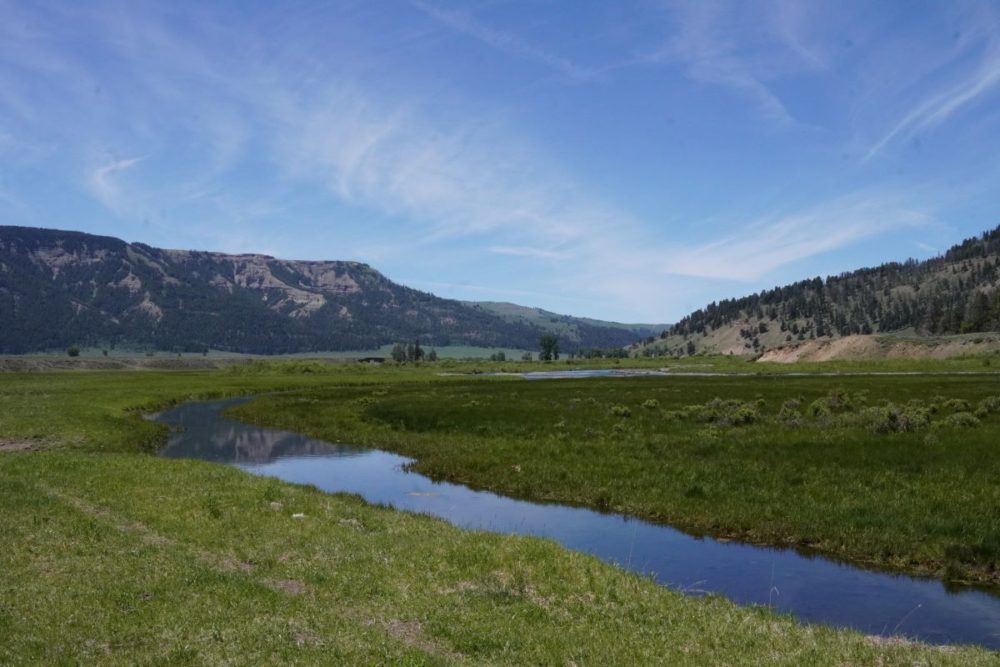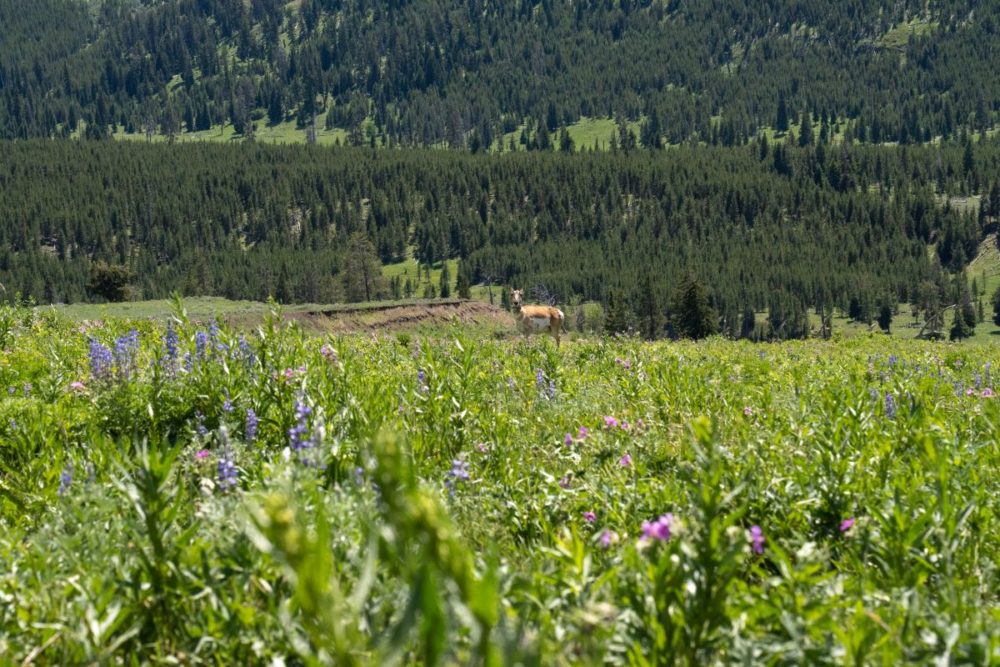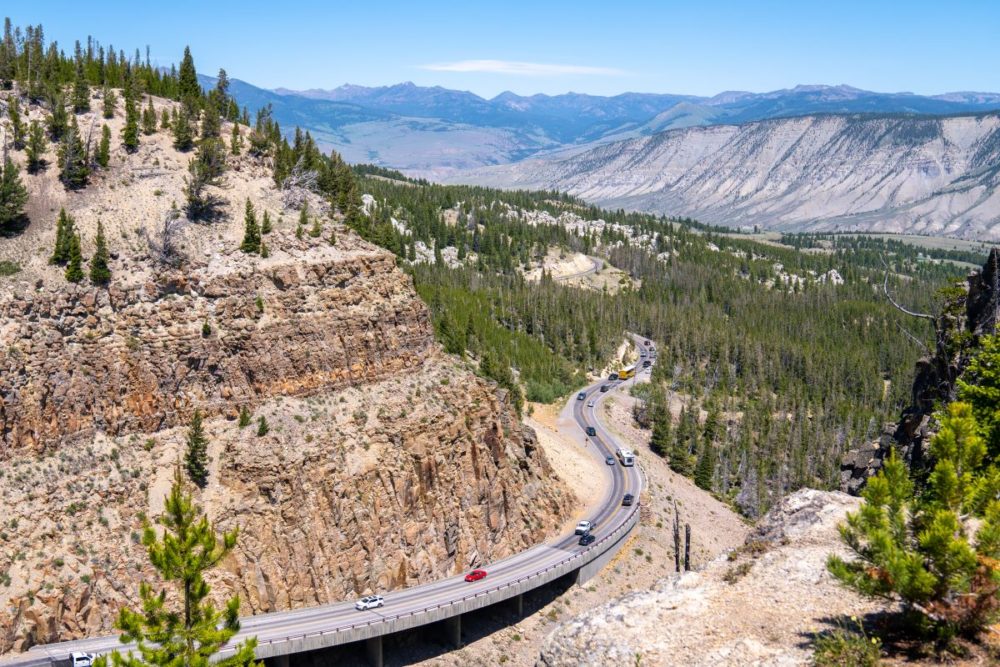Yellowstone National Park is famous for its bubbling geysers and diverse wildlife. The variety of terrains across the park make it one of the most unique places to visit in the United States. Although many of Yellowstone’s natural wonders are visible from man-made viewing points, hiking in the park gives you access to remote views that are truly unbeatable. The best hikes in Yellowstone are not technically challenging and can easily be fit into a day’s itinerary. Here are the 5 best hikes in Yellowstone National Park.
Table of Contents
5 Best Hikes in Yellowstone National Park
1. Lamar River Trail


Difficulty ★ ☆ ☆ ☆ ☆
Elevation Gain –800 ft
Total Length – Varies, out and back
The Lamar Valley is known as the best place to view wildlife in Yellowstone. As you enter the Valley, you’re met with sweeping views of mountains on either side, divided by lush fields that stretch on for miles. The vastness of the Valley is unparalleled, and it’s what makes the area so renowned.
The Valley is beautiful from the road, but you can get even better views from the Lamar River Trail. There is only one road that runs through Lamar Valley. If you’re driving towards the northeastern gate, the trailhead will be on your right side, next to the road. First you’ll see the Lamar River Stock Trailhead, which is for horseback riders. Continue driving and the walking trailhead is right up the road.
If you look up the Lamar River Trail on All Trails, don’t be discouraged by its listed length of 37.6 miles. The trail is mostly flat with a very slight incline and it can easily be shortened. You can get the experience of being fully immersed in the Valley after only 1-2 miles of walking. One of the most popular routes on the trail takes you to Cache Creek and back, which is approximately a total of 8.6 miles. The trail to Cache Creek is a little tricky to follow on the map, but I found a great detailed description here: http://www.tetonhikingtrails.com/lamar-river-trail.htm
2. Bunsen Peak Trail
Difficulty ★ ★ ☆ ☆ ☆
Elevation Gain –1,300 ft
Total Length – 4.4 miles out and back
Bunsen Peak is a mountain located in the Northern section of Yellowstone. The trail up the mountain is a scenic hike that takes you through multiple types of terrain. The hike starts off gradually in the dense, tree-covered areas of the mountain. As you begin to gain elevation, the trees become more sparse, providing great lookouts to the winding road and beyond.

After about a mile, the trees will completely clear and you’ll reach an open area filled with lush greenery and wildflowers. It is here that you’ll first see this view of Swan Lake Flat and the frosty snow-capped mountains. As far as landscape scenic views go, this view is tied with Lamar Valley for the best landscape view in the whole park!

To be honest, the view at this point is almost exactly the same as the view at the summit. If I were to hike Bunsen Peak again, I would only hike 1 mile to this point, enjoy the view, and then save my energy to explore other parts of the park. If you choose to continue to the summit, the rest of the trail has steep switchbacks on rocky terrain. Although it’s a relatively easy trail, I highly recommend wearing hiking boots.
3. Canyon Rim South Trail to Point Sublime
Difficulty ★ ☆ ☆ ☆ ☆
Elevation Gain –800 ft
Total Length – 6.4 miles out and back
The Grand Canyon of Yellowstone is located on the Eastern side of the park and stretches for 24 miles along the Yellowstone River. Unlike the cool blues and greens of the scenery described in the hikes above, this Canyon is fiery and warm.
The Canyon Rim South Trail starts at the first parking lot you reach after turning onto South Rim Drive. The trail takes you first past the upper and lower falls and then to Artist Point. The Artist Point Lookout is one of the most popular places to visit in Yellowstone, and is often very crowded with families and tour buses. The view is beautiful and is definitely worth a picture break, but the best part of this trail is the second half, once you’re past the more easily accessible areas.

As soon as you pass Artist Point, the trail becomes significantly less crowded and takes you further along the edge of the Canyon. Since this portion is less trafficked, there are no handrails or manmade safety measures along the edge. Because of this, I do not recommend this part of the trail for anyone with young children or if you have an intense fear of heights.

However, this part of the trail has the best views of the Canyon. The warm colors become more brilliant and are strewn across the Canyon walls like a painted sunset. Resilient trees are scattered amongst the steep rock faces and if you dare look down, you can see the turquoise Yellowstone River rushing through the rocks below.

4. Grand Prismatic Spring Overlook

Difficulty ★ ☆ ☆ ☆ ☆
Elevation Gain –200 ft
Total Length – 1.6 miles out and back
The Grand Prismatic Spring is one of the most photographed spots in Yellowstone. Famous for its bright colors and size, Grand Prismatic is a must-see for all visitors. There are two ways to view the Spring. Either you can walk alongside it on the wooden viewing ramps, or you can take the Grand Prismatic Overlook Trail to see it from a bird’s- eye view above.
The trailhead for the Grand Prismatic Spring Overlook is located in the same parking lot as the Fairy Falls trailhead. This parking lot is tiny and is located slightly south of the Spring. The larger parking lot right next to the Spring and Midway Geyser Basin is only for access to walk alongside the geysers.
Since this is such a popular spot and the parking lot is small, the best time to take this hike is first thing in the morning or in the evening, just before sunset to avoid crowds. This is a highly-trafficked, very easy hike that is the best hike for kids and families in Yellowstone.
5. Fairy Falls

Difficulty ★ ☆ ☆ ☆ ☆
Elevation Gain –200 ft
Total Length – 4.8 miles out and back
Fairy Falls is one of the biggest waterfalls in Yellowstone National Park. As noted above, the trailhead to Fairy Falls is located in the same parking lot as the Grand Prismatic Spring Overlook trailhead and parking is very limited. Taking the trail to Fairy Falls is less of a hike and more like a leisurely stroll. If you’re looking to hit the trails, but don’t want elevation gain, this is the trail for you. The trail meanders through a pine forest where you can see the remnants of past forest fires, along with the different stages of regrowth. At the end of the trail you’ll reach the base of the waterfall. There are plenty of rocks and logs to sit on around the waterfall base. Have a seat, take some photos and enjoy the rushing sounds and cooling mist of Fairy Falls.
The best hikes in Yellowstone are both easy and accessible to all. The scenic views they lead to are unbeatable and are a must-see during your next trip to Yellowstone National Park.
Happy Hiking,
Kira
Looking for more more hiking inspiration? Click here for more tips and guides!